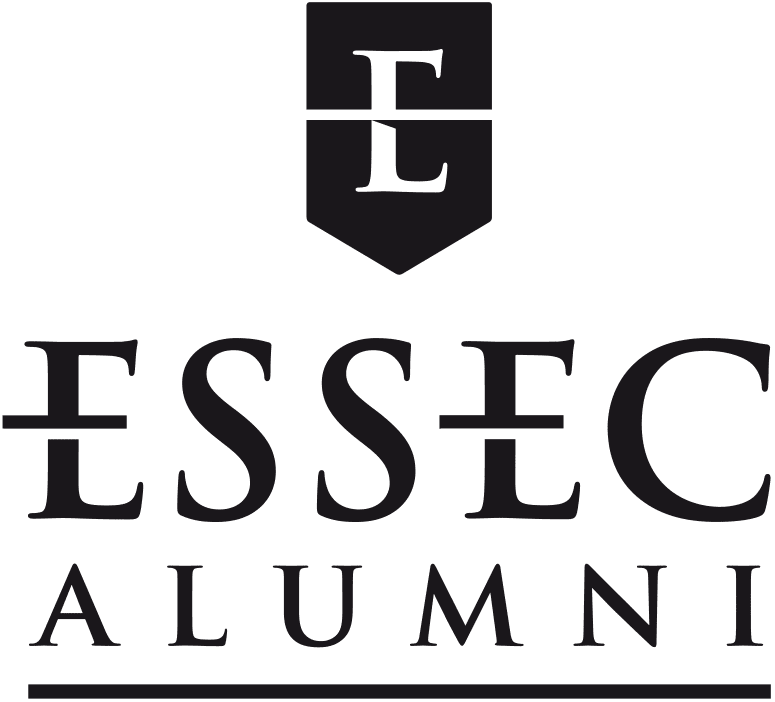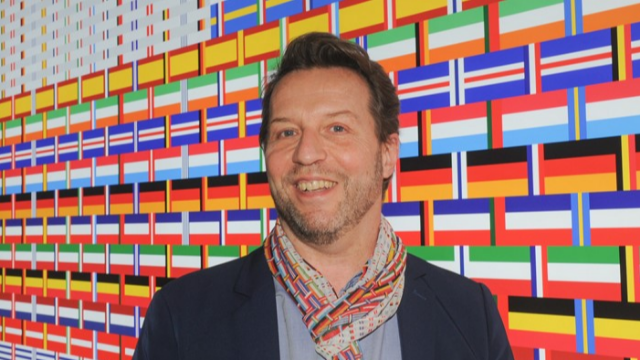Marc Hivernat (E86): “France Has Always Attached Great Importance to Culture”
To celebrate the French Presidency of the Council of the European Union, Marc Hivernat (E86) has installed L’Étoffe de l’Europe TM (“the Fabric of Europe”) at the institution’s headquarters in Brussels, a scenography project combining data, French craftsmanship and ecodesign. He gives us a behind-the-scenes look at this unprecedented initiative bringing together culture, education and diplomacy.
ESSEC Alumni: How has your path led you to this role as the project leader for L’Étoffe de l’Europe TM with Ateliers Adeline Rispal?
Marc Hivernat: I have always wanted to combine my creative nature with my training as a manager to serve cultural projects. At the start of my career, this was not easy: management and culture seemed contradictory in the 1980s. Yet I was able to find my first position at the Comédie Française, before helping to create the cultural engineering agency for Groupe Caisse des Dépôts and later founding Créatibus, a distance selling company for cultural leisure products, and then successively holding the positions of Associate Editor for the publisher Mango Éditions, Managing Partner of Rhizomes, a communication agency specialised in the heritage of brands, Managing Director of Fondation Lafayette and, finally, Managing Director of Ateliers Adeline Rispal.
EA: Can you tell us more about the Ateliers Adeline Rispal?
M. Hivernat: In 30 years, Ateliers Adeline Rispal has become the agency specialised in cultural engineering, architecture and space design. Our expertise, recognised in France and internationally, is that of “cultivating spaces” for our clients in the areas of culture and heritage as well as in the retail, service and mobility industries. Whether they are physical or digital, the spaces we create always embody the values of a place, the users’ needs and the corporate culture of its sponsors. We take a comprehensive and environmentally ethical approach.
EA: Tell us about the Étoffe de l’Europe TM project led by Ateliers Adeline Rispal.
M. Hivernat: It is a scenic design project created in cooperation with the graphic design agency Studio Irresistible, which exists in several forms–textile, digital and artistic–throughout seven spaces of the Council of the European Union, on the occasion of the French Presidency.
EA: What were the different stages in the creative process that resulted in L’Étoffe de l’Europe TM ?
M. Hivernat: We entered an architecture and scenic design competition. In less than a month, we had developed the general concept for the project. Our proposal was unanimously selected by a jury chaired by Hervé Lemoine, Director of Mobilier National, and composed of prominent figures including architects Corinne Vezzoni, Paul Chemetov and Bernard Desmoulins. We then worked for six months to produce the project, up to its installation in Brussels, which took place just three days at the start of January 2022.
EA: L’Étoffe de l’Europe TM was created using data design – and specifically data-weaving. What is that?
M. Hivernat: From a historical and scientific perspective, data undeniably offers a playground for creativity. The idea of data-weaving came to us as a way of explaining the complexity of European construction more simply. In the same way that the warp and weft threads come together on a loom, L’Étoffe de l’Europe TM was woven together by combining ribbons designed with 37 Pantone colours identified in the 27 flags of European nations. Freely and artistically interpreted from the start, a ribbon was produced for each flag and validated diplomatically by the embassies in France for each Member State. The warp threads are made up of ribbons from countries that have been part of the European Union since its inception, and the weft threads are made of ribbons from the countries that hold the rotating presidency every 6 months. From 6 countries in 1958 to 27 today, we can better comprehend the full extent of the patient construction of the European Union as the fabric expands. Likewise, Brexit is perceptible: the removal of the UK ribbon in 2019 is visible in the weaving, like a ladder in a pair of stockings.
EA: How has the Étoffe de l’Europe TM concept been embodied in the different spaces chosen for the project?
M. Hivernat: The general theme takes on various forms as it enters new spaces, adapting to the different scales and materials used to create the scene. The data weaving used as a representation of the building of Europe can also be seen in the 16-metre-long backlit fresco installed in Forum Europa, where conferences of Heads of State are held. It is also present in the Atrium Juste Lipse, in a spectacular, monumental form: 2 large wings printed on non-woven fabric, each made up of 10 strips of fabric framing the building’s central entrance and exit aisle. They cover some 650 m2, reach a height of 4 metres and rely on a system that can be dismantled and reassembled in 6 hours to comply with the constraints for the use of each site. The motif has also been adapted to line the inside of 12 lift shafts.
(photo)
EA: In what way does the Étoffe de l’Europe TM showcase French artistic talent?
M. Hivernat: At the inauguration of the Étoffe de l’Europe TM, the Minister of Culture reminded us that scenic design productions are fully-fledged artistic creations. Scenography is a multidisciplinary discipline that draws on multiple areas of high-level expertise to produce collaborative works. In addition, the general concept for the project prompted us to place orders with French artists.
EA: Which French artists did you work with for to create L’Étoffe de l’EuropeTM ?
M. Hivernat: Jacques Perconte, a major figure in the digital scene, created Aour Europe, an impressionistic work incorporating sound, designed as a digital weaving of natural European landscapes. Jeanne Goutelle, a textile artist, designed Intersection(s), a line of screens incorporating aspects of art, craftsmanship and design, woven using leftover fabric from the textile industry in St-Étienne. We also partnered with Mobilier National to showcase Hémicycle, the most recent line of chairs created by designer Philippe Nigro. For the Décors & paysages exhibition, commissioned by Léa Meotti, we presented works by 6 emerging artists from the French art scene living in Belgium: Léa Belooussovitch, Jérôme Bonvalot, Vincent Chenut, Loup Lejeune, Lise Peroi, and Lucien Roux.
EA: Which aspects of the French presidency of the EU council does L’Étoffe de l’Europe TM highlight?
M. Hivernat: All scenography is a political project, in the purest sense. We were inspired by the 3 major ambitions that France has set for its governance of Europe. L’Étoffe de l’Europe™ symbolises the belonging of 450 million citizens while also expressing the diversity of their cultures. It expresses the power of a collective working together day after day to weave a common dynamic in the new world order. Its mesh pattern provides a visual of the renewal of relations between nations, the flow of people and goods, the data and information exchange networks within Europe and with the rest of the world.
EA: France has also set the objective of raising awareness in Europe on ecological and digital transition issues…
M. Hivernat: Our project is exemplary in this respect since our ecologically responsible approach led us to seek ethical solutions in terms of materials, manufacturing processes, recycling, energy usage, reduction of negative impacts and waste generated by the worksites, short supply chains, upcycling and moderate use of technology…
EA: What role does culture play in this French Presidency of the EU Council?
M. Hivernat: France has always attached great importance to the culture of Europe. For this French presidency, the Ministry of Culture has announced over 150 cultural events that will be held in France and throughout Europe, which will include key artistic performances aimed at informing citizens of the European Union’s cultural initiatives.
EA: What is your view of the European cultural policy?
M. Hivernat: Historically, the European Union was initially built on economic foundations. A European cultural policy was then gradually developed, based primarily on the promotion of cultural diversity and intercultural dialogue. It was with the Maastricht Treaty in 1992 that the EU significantly broadened its competencies in order to contribute to the cultural development of its Member States, seeking to respect national diversity, while also highlighting a common heritage. This is precisely what L’Étoffe de l’Europe TM embodies.
EA: The COVID-19 crisis has called into question the “essential” nature of culture. Do you believe that each national presidency of the EU Council should be marked by symbolic initiatives like L’Étoffe de l’Europe TM ?
M. Hivernat: I am deeply convinced that culture and education are the levers for the development of any time of project. Even beyond the tradition of each country designing the EU Council’s in their own unique way during their presidency, Brussels offers a wonderful opportunity for showcasing the various artistic and cultural expressions of all Member States. The only drawback is that the general public has very limited access to these spaces. We therefore wanted L’Étoffe de l’Europe TM to be very visible on social media. We have also established it as a brand destined to live on even after the half-year term of the French presidency.
EA: What will happen to L’Étoffe de l’Europe TM after the French presidency of the EU Council?
M. Hivernat: In terms of the exhibitions on display in Brussels, the specifications for the design project stipulate that the works must be dismantled to be recycled, and this will be followed. However, the levels of enthusiasm for this project open up possibilities for alternative opportunities, although it is still too early to say with any certainty. As for the L’Étoffe de l’Europe TM brand, we have already prototyped and produced a few associated products, both textiles and other items, which are all environmentally friendly. However, there are a wide range of possibilities for variations on the design, in many different contexts, from lifestyle to luxury items, layout designs and facilities. Many different publishers and operators have contacted us. It is a lot of fun and remains a very creative experience!
Interview by Louis Armengaud Wurmser (E10), Content Manager at ESSEC Alumni
Want more content? Join us now so that we can keep bringing you news about the ESSEC network.

Comments0
Please log in to see or add a comment
Suggested Articles


